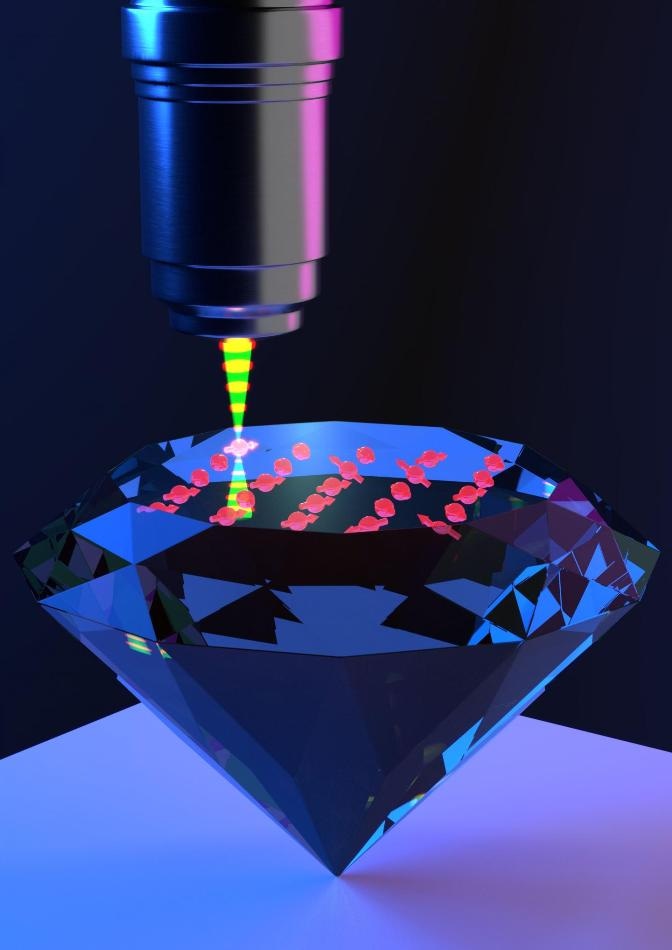May 15 2019
The unique phenomena of quantum entanglement and superposition are used by quantum technologies to encode and process information, with enormous advantages to an extensive range of information technologies from communications to computing and sensing.
 Laser writing of individual nitrogen-vacancy defects in diamond with near-unity yield. (Image credit: Oxford University)
Laser writing of individual nitrogen-vacancy defects in diamond with near-unity yield. (Image credit: Oxford University)
Yet, a major difficulty encountered in developing these technologies is that the quantum phenomena are highly fragile. Very few physical systems have been identified in which they live long enough and are adequately controllable to be useful. Atomic flaws in materials like diamond are one such system; however, a lack of approaches for the fabrication and engineering of atomic-scale crystal defects has restricted the advancement to date.
In a study reported in Optica, a group of researchers shows the success of the new technique in fabricating specific defects in diamonds called nitrogen-vacancy (NV) color centers. These include a nitrogen impurity in the diamond (carbon) lattice distributed close to an empty lattice site or vacancy.
The NV centers are fabricated by concentrating a series of ultrafast laser pulses into the diamond. The energy of the first laser pulse has energy sufficiently high to produce vacancies at the center of the laser focus. The subsequent pulses have lower energy to mobilize the vacancies until one of them is bound to a nitrogen impurity and forms the needed complex.
The new study was performed by a group headed by Prof. Jason Smith from the Department of Materials, University of Oxford, and Dr Patrick Salter and Prof. Martin Booth from the Department of Engineering Science, University of Oxford, together with coworkers at the University of Warwick. It was conducted within the research program of NQIT, the Quantum Computing Technology Hub of the UK Quantum Technologies Programme, with support from DeBeers UK who supplied the diamond sample.
The new technique developed by the researchers involves using a sensitive fluorescence monitor for the detection of light emitted from the focal region, thereby enabling the process to be actively controlled with respect to the observed signal. The new approach involves combining local control and feedback, thereby facilitating the production of arrays of single NV centers with precisely a single color center at each site—an important potential while developing scalable technologies. It also enables the defects to be precisely positioned, which is vital to engineer integrated devices. It is possible to easily automate the quick single-step process with each NV center requiring only a few seconds to create.
Colour centres in diamond offer a very exciting platform for developing compact and robust quantum technologies, and this new process is a potential game-changer in the engineering of the required materials. There is still more work to do in optimising the process, but hopefully this step will help to accelerate delivery of these technologies.
Prof. Martin Booth, Department of Engineering Science, University of Oxford
The researchers consider that this approach might eventually be used for the fabrication of centimeter-sized diamond chips that contain more than or equal to 100,000 NV centers as a path toward the “holy grail” of quantum technologies, a universal fault-tolerant quantum computer.
The first quantum computers are now starting to emerge but these machines, impressive as they are, only scratch the surface of what might be achieved and the platforms being used may not be sufficiently scalable to realise the full power that quantum computing has to offer. Diamond colour centres may provide a solution to this problem by packing high densities of qubits onto a solid state chip, which could be entangled with each other using optical methods to form the heart of a quantum computer. The ability to write NV centres into diamond with a high degree of control is an essential first step towards these and other devices.
Prof. Jason Smith, Department of Materials, University of Oxford